Enquanto dormimos, a cidade nos arranha


-
Novas formas de vida
pintura
190 x 200cm
Acrílica sobre papel arroz
2020
-




-
Sem título, monitores 1
escultura
20,5 x 36cm
Liga de estanho e chumbo
monitor lcd quebrado
e pregos de aço
2020
-




-
Plástico, alumínio, papel
escultura
13 x 21cm
Plástico, alumínio e papel
2020
-



-
Água viva
Instalação
Dimensões variáveis
Projeção sobre tela
de proteção do copan
e escada de alumínio
2020
-



-
Baby alien 2
escultura
33 x 47 x 53cm
Alumínio, silicone, berço de papel
de fones de ouvido de celular
e ar condicionado usado
2020
-



-
Dois mil e noite (tríptico)
Pintura
190 x 340cm
Nuvem de pontos gerada
com programação em javascript
por processamento de som
coletado em caminhada noturna
no centro de São Paulo,
desenhada com isqueiro
sobre manta asfáltica
2016-2020
-


-
Sem título (flutívago)
Escultura
75 x 120 x 50cm
Fantasia de E.T e fio de alumínio
de cabeamento elétrico urbano,
coletado na praça da república
em obra de manutenção da eletropaulo
2018-2020
-





-
Derretido, objeto sensível
Escultura efêmera
16 x 21cm
Nuvem de pontos gerada
com programação em javascript
por processamento de som
coletado no centro de São Paulo,
desenhada com ferro de solda
sobre um disco de gálio (metal com ponto de fusão de 29.76°C)
dentro de sacola plástica fixada com imã de neodimio
sobre fachada de vidro do Copan
2020
-



-
Pele dos edifícios
Escultura
39 x 50cm
Manta asfáltica e alumínio
2020
-




-
Shopping Center
Escultura de parede/digital
30 x 30cm
Alumínio, vidro, polarizador,
adesivo transparente e sala digital
2020
-

-
Mentira - miragem
Escultura
50 x 50cm
Display holográfico e vídeo
2020
-




-
Casulo
Escultura
70 x 130cm
Alumínio, borracha, plástico e ferro
2020
-


-
Invasor I
Escultura
Dimensões variáveis
Fita hellerman preta
2020
-


-
Invasor
Escultura
80 x 120cm
Silver tape e plástico
2020
-


-
objeto sonoro
escultura
dimensões variáveis
alumínio, asfalto, spray e silicone.
2020
-
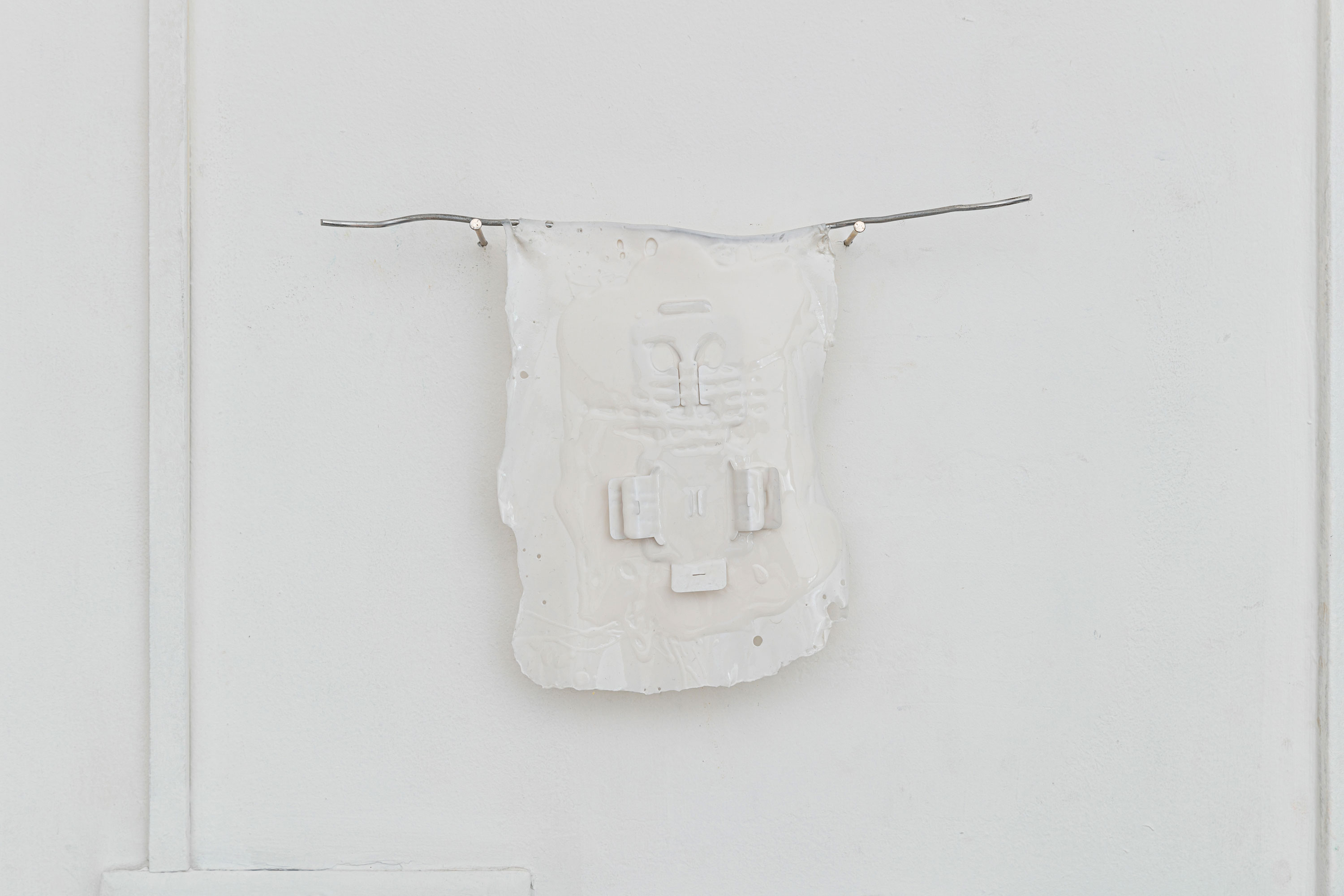
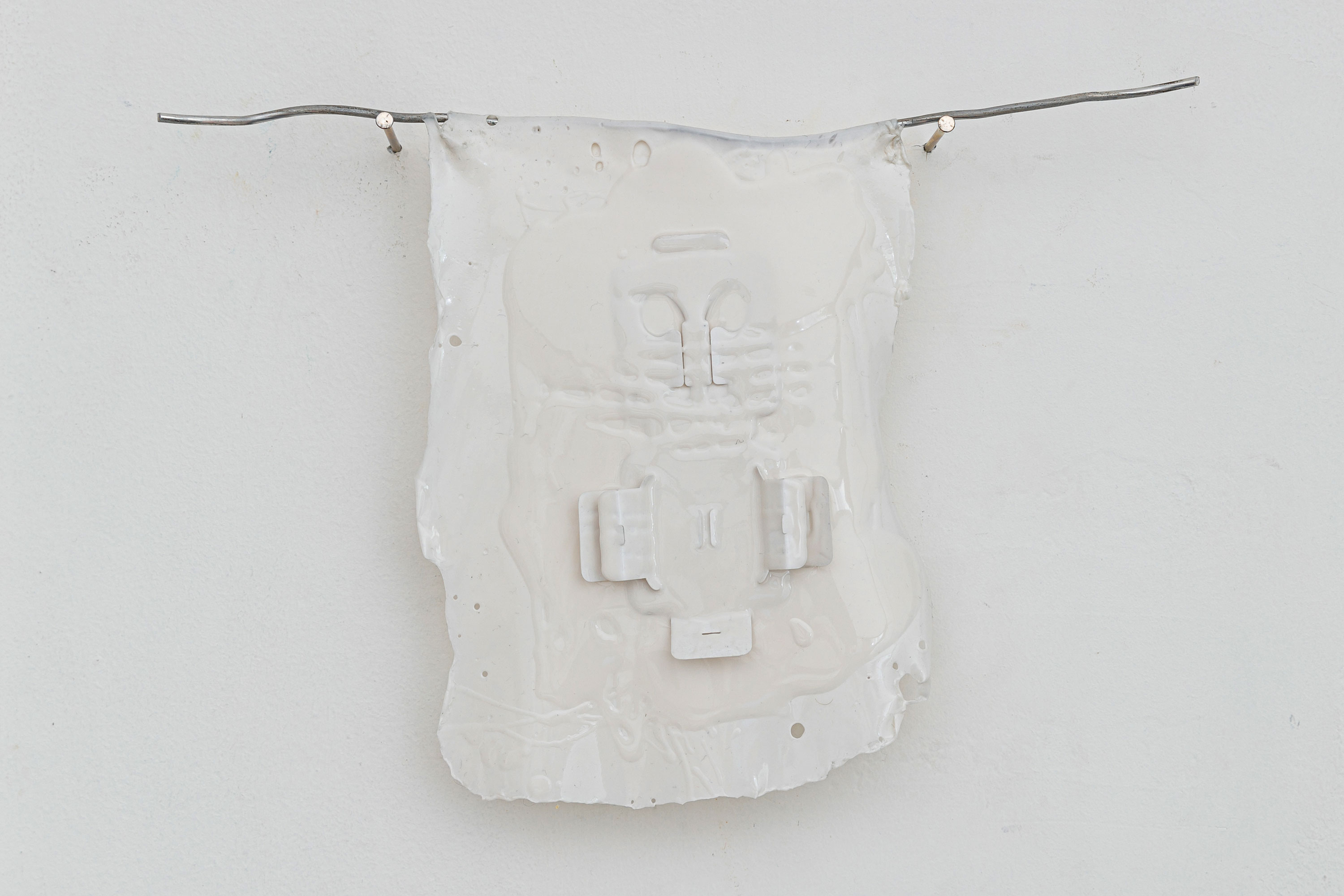
-
baby alien 1
escultura de parede
22x15cm
alumínio, suporte de fones
de ouvido de celular e silicone.
2020
-
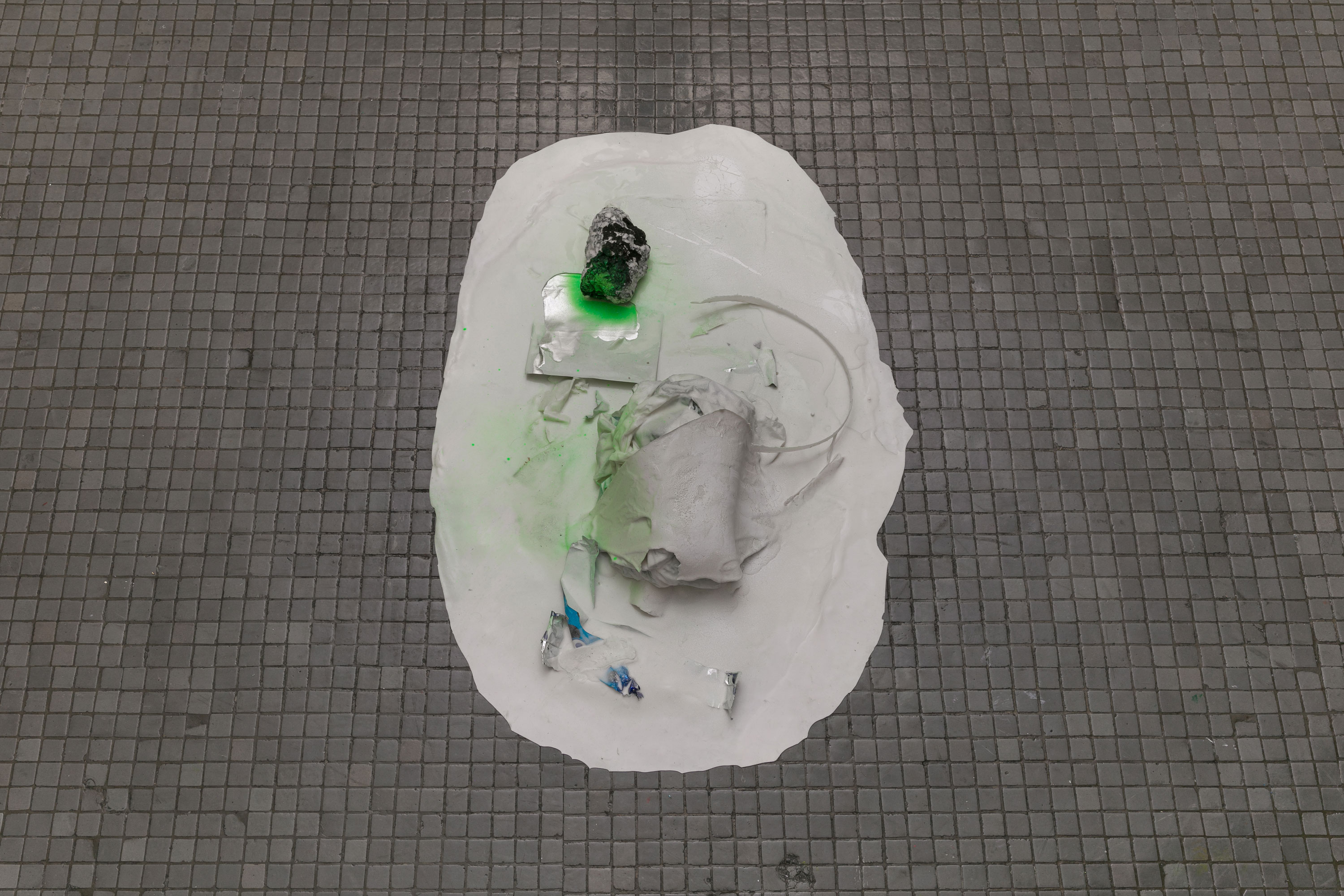
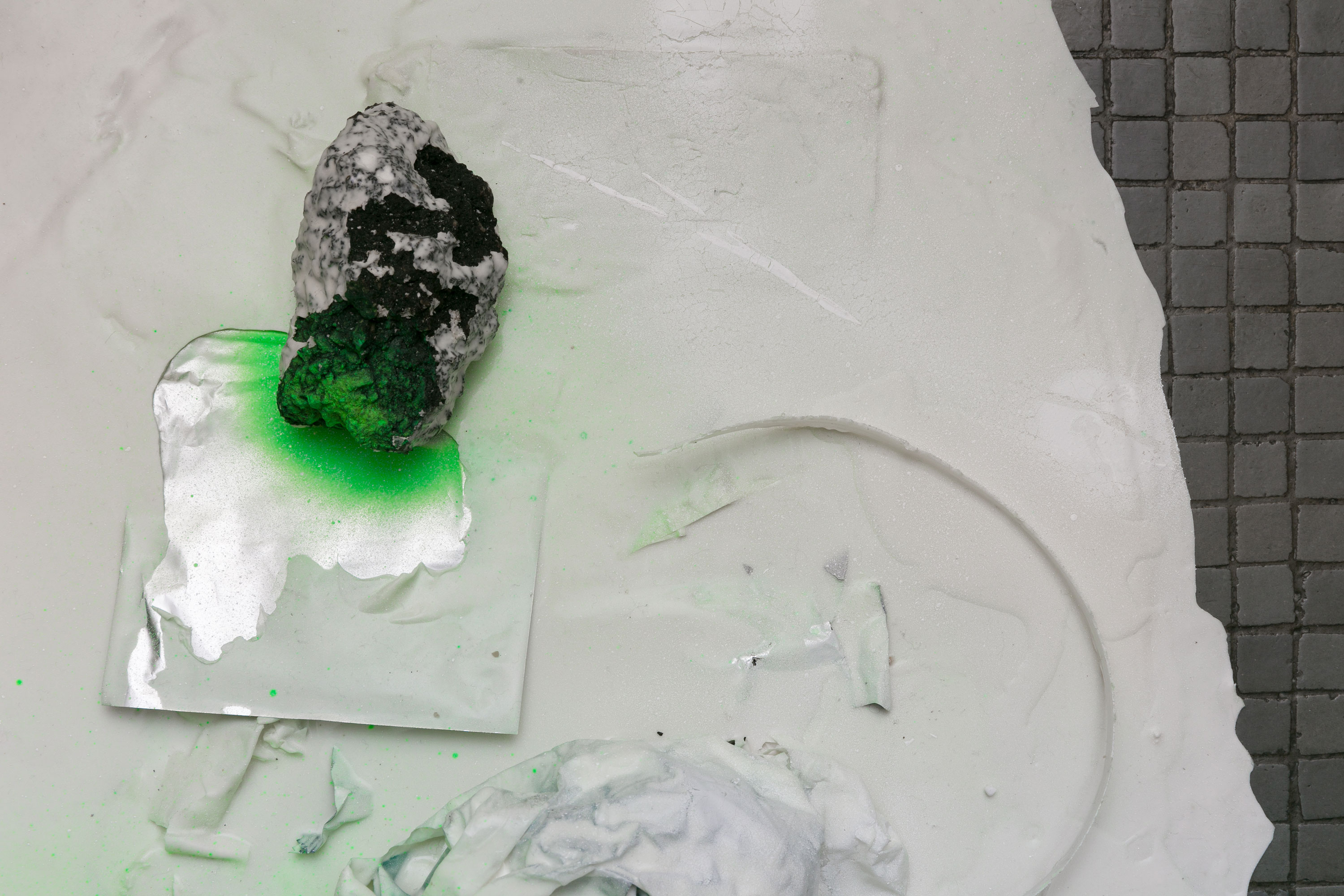
-
sem título
escultura de chão
40x60cm
silicone, sacolas plásticas
embalagens metálicas, asfalto,
detritos plásticos e spray
2020
-
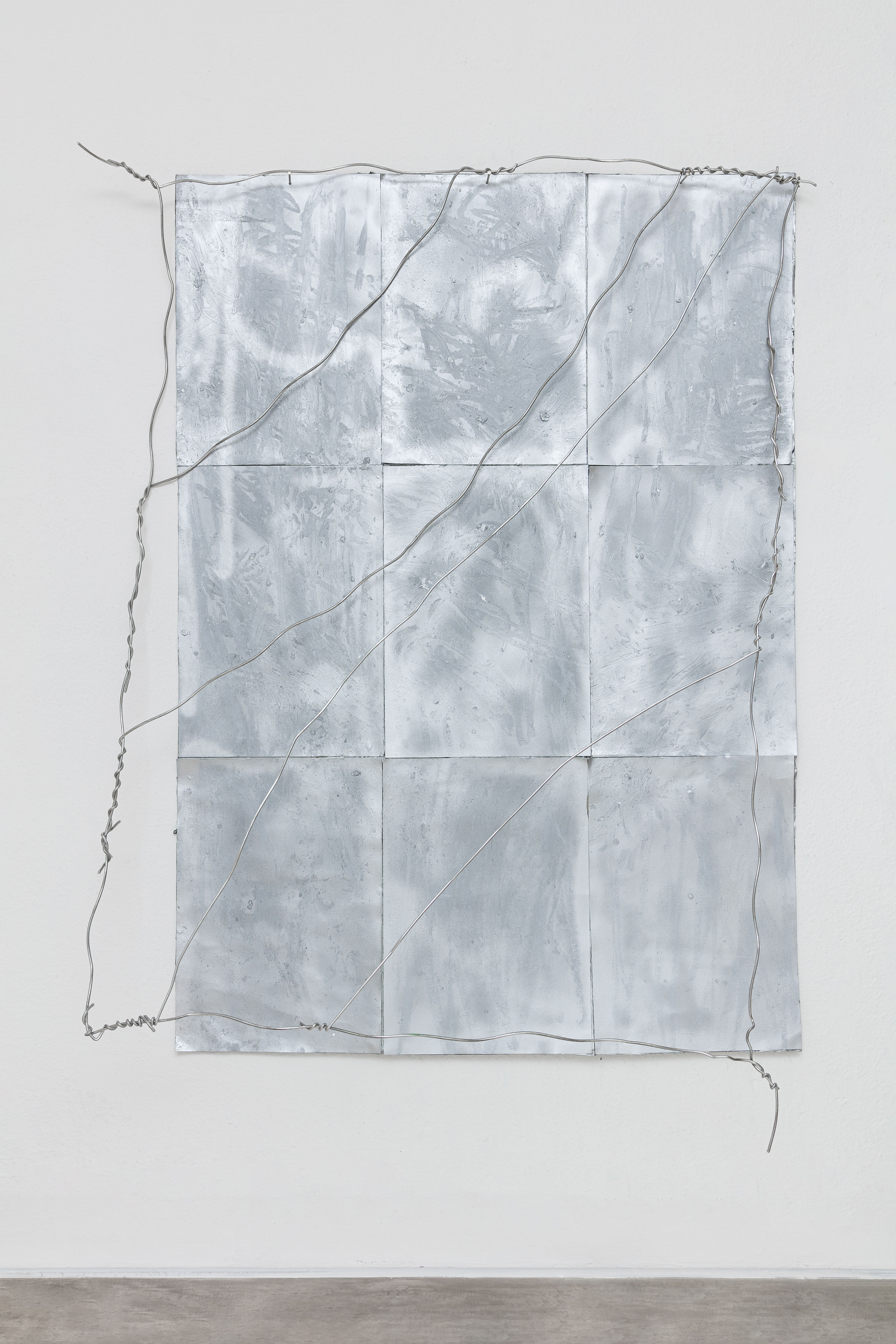
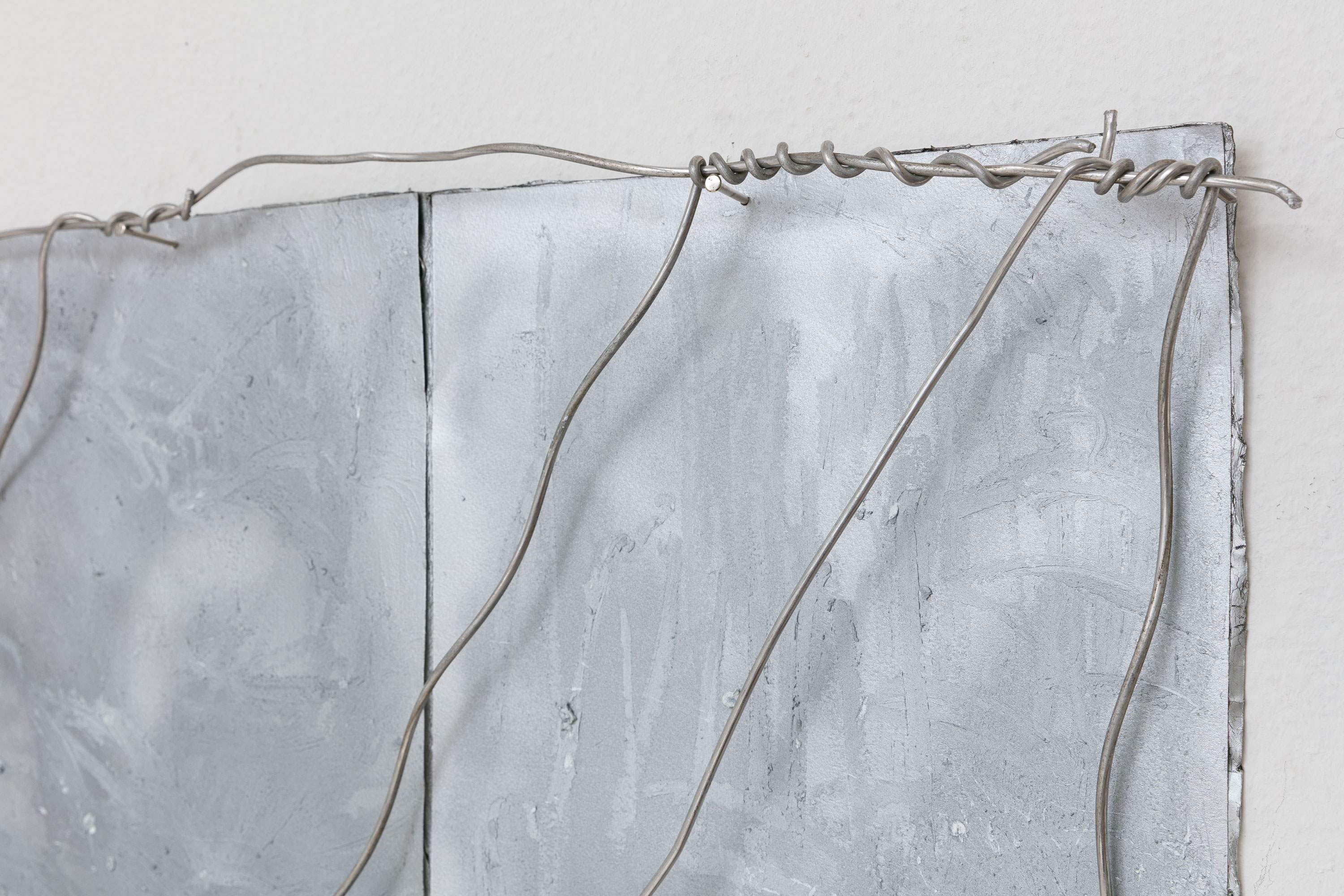
-
enquanto dormimos, a cidade nos arranha
pintura
90x130cm
alumínio, folhas de alumínio,
spray, guache, bastão oleoso
s/ papel s/ fita de isolamento térmico
2020
-
fotos: ana pigosso
Av. Ipiranga 200, bloco B, apto. 2618
Em agosto de 2017 mudei para uma unidade de 40m2, no vigésimo sexto andar do edifício Copan de frente à marquise. A vista e os ruídos da cidade eram parte da arquitetura e pareciam responsáveis pela sustentação do prédio tanto quanto o concreto.
Durante três anos coletei materiais, imagens, sons e objetos. Dessas coletas e fragmentos, lentamente construí um corpo de trabalho.Em setembro de 2020, após 6 meses de isolamento, a exposição foi aberta. Visitas agendadas e recebidas uma a uma. Mais do que expor objetos, meu interesse estava nas fricções que aconteciam naquele lugar específico, rodeado por sons, concreto e eletricidade, onde a confluência entre cidade, corpo e matéria gerara um ambiente no qual era possível observar um grande sistema de relações e rastros no tempo provocados pelo enlace social. Uma cadeia constituída de íntimas ligações humanas e não humanas.
ENQUANTO DORMIMOS, A CIDADE NOS ARRANHA
Dirigido por Leos Carax, o filme Os amantes da Ponte Neuf (1991) narra a relação entre Alex e Michèle, moradores de rua que orbitam a mais antiga das pontes sobre o rio Sena, em Paris. Ele é um malabarista e acrobata alcoólatra, ela é uma artista visual que está ficando cega. Marginais em um mundo de beleza e sucesso, a dupla se cruza nas zonas sombrias da capital francesa. Aí, a ponte e a cidade, mais do que cenários, são interlocutores que abrigam e que de certa forma definem os rumos desse amor florescido na noite, que habita o barro e as folhas das ruas.
Enquanto dormimos, a cidade nos arranha, individual de Simon Fernandes no Edifício Copan, não trata do amor – ao menos não diretamente. Aqui, no entanto, como no filme de Carax, a cidade é o lugar e o agente catalisador dos afetos e dos eventos; aqui, como lá, é a partir dela que vislumbramos não só as chances do encontro mas também as da ação ou gesto artístico. E não só: no filme como na exposição, estamos incrustados no tecido urbano. É ele que nos oferece a matéria-prima – física, e também sensível – sobre a qual o trabalho se desenvolve, elaborando, depois de uma longa convivência, as formas e os conceitos que nos refletem e que de algum modo nos acolhem.
As obras reunidas em Enquanto dormimos, a cidade nos arranha ecoam a cidade e seus ruídos. A alusão ao som não é acidental: como elemento constituinte da experiência urbana, ele está presente de diferentes maneiras na exposição, explorado enquanto matéria escultural capaz de interferir no espaço e nos corpos que o cruzam. Entremeados por pequenas paisagens sonoras, nos entregamos a essa espécie de escuta tátil e sem grandiloquência, fundada também pelos seus silêncios e suas pausas.
O Copan, como grande escultura sonora, é metáfora ideal para esta relação entre corpo e som. Prenhe de ruídos que interagem de diferentes modos com a matéria que o constitui, o prédio funciona como microcosmo da cidade que o rodeia. Estabelecendo uma relação especular com sua estrutura, algumas obras exploram as tensões entre material e desenho, desdobrando a impressão provocada pelo edifício, ao mesmo tempo leve (em sua visualidade) e pesado (em sua dimensão matérica).
Diferente da obra de Niemeyer, no entanto, na exposição temos, mais que um grande gesto, sua dispersão e ruptura. Pois os trabalhos de Simon Fernandes são feitos das sobras e dos restos do que constrói o lugar em que vivemos: refugos e pigmentos industriais; materiais da construção civil; piche; plásticos. Em nenhum há nobreza nem se vê busca por qualquer forma de transcendência. Ao contrário: a fragilidade de algumas estruturas evidencia a força entrópica que nos habita e ao nosso dia-a-dia; estamos, diante de algumas obras, à beira do colapso.
Em outras, a entropia surge não como queda, mas como processo transformador; aí, contemplá-la é acolher a passagem do tempo e as mudanças que ela traz. Nesse mesmo sentido, a escolha dos materiais reflete o desejo de vê-los respondendo às forças físicas – calor, gravidade – que os alteram e deterioram, explorando sua precariedade e perecibilidade. Um desejo semelhante leva à exibição dos avessos da arquitetura, dando a ver, como ocorre na costura, os indícios de um trabalho igualmente transformador e discreto. Nesse gesto, a exposição revela sua sutil força política, baseada não só na evocação da pólis como elemento central da elaboração poética, mas em tornar visíveis as diversas formas do labor que a constrói e sustenta.
Apesar de sua importância como abrigo e motriz da fabulação poética, o Copan não é o único lugar onde a exposição se desenrola. Inseridas no espaço urbano, às vezes mimetizando suas cores e estruturas, algumas obras estão instaladas nas calçadas que circundam o edifício. Como oferendas ao fluxo das ruas, podem ser levadas embora (é provável que o sejam), desmontadas e ter seus materiais reaproveitados em outras circunstâncias, para outros fins.
Um terceiro grupo, ainda, habita a sala virtual desenhado pelo artista para este projeto. Acessível por meio da leitura de um QR code, ela guarda um desdobramento dessa espécie de inventário que permeia as obras reunidas aqui. Registro imaterial do peso concreto que de outro modo nos circunda, a existência desse terceiro espaço sublinha a importância da subversão técnica que está presente de diferentes maneiras na exposição.
As cidades, como as carcaças, sustentam e alimentam a vida de muitos seres. Embora inanimadas, são, por metonímia, algo vivo: pois tomam um pouco da vida de todos que as habitam. Assim elas nascem, se expandem e duram; graças a esse vínculo, também, algumas vezes morrem. A relação algo erótica que estabelecemos com seus espaços não nos poupa de seu caráter eventualmente atroz. Percebê-las como coisa sensível, e as interseções entre os nossos corpos e o seu, é condição para habitá-las; talvez seja, do mesmo modo, condição para habitarmo-nos.
ENQUANTO DORMIMOS, A CIDADE NOS ARRANHA
(english version)
Directed by Leos Carax, the film The Lovers on the Bridge (Les amants du Pont-Neuf, 1991) follows the relationship between Alex and Michèle, two vagrants that orbit the oldest of the bridges over the river Seine, in Paris. He is a juggler and acrobat addicted to alcohol, and she is a visual artist turning blind. Marginals in a world of beauty and success, the couple meet in the shadowy zones of the French capital. There, the bridge and the city, more than a set, are characters that shelter and somehow define the course of this relationship flourished in the night, inhabitant of the mud and leaves of the streets.
Enquanto dormimos, a cidade nos arranha [As we sleep, the city scrapes us], solo show by Simon Fernandes at the Copan Building, in the city center of São Paulo, does not talk about love – at least not directly. Here, however, as in Carax film, the city is the place and the catalyst agent of affections and events; here, as in there, it is inside the city that we glimpse the chances of an encounter, and also of an artistic action or gesture. Not only this: in the exhibition, just like the film, we are inlaid in the urban fabric. It is the source of raw material –physical but also sensible– from which the work is developed, elaborating, after a long coexistence, the forms and the concepts that reflect and in a sense welcome us.
The works gathered in Enquanto dormimos, a cidade nos arranha echo the city and its noises. The allusion to sound is not accidental: as a constitutional element of the urban experience, sound is present in different ways in the exhibition, explored as sculptural matter capable of interfering on space and on the bodies that cross it. Trespassed by small sound landscapes, we give ourselves to this sort of tactile listening, founded without any grandiloquence also by its silences and pauses.
Landmark building designed by Oscar Niemeyer, Copan works as a huge sound sculpture and is the ideal metaphor for the relationship between body and sound. Pregnant with noises that interact in different ways with the physical matter that makes it, the building works as a microcosmus of the surrounding city; in a specular relationship with the place, some of the works explore the tensions between design and material, developing the impression provoked by the building, at the same time light (in its visuality) and heavy (in its materic dimension).
Different from Niemeyer's creation, however, in the exhibition we have the dispersion and rupture of the great gesture. Because the works by Simon Fernandes are made of leftovers and rests of what builds the places we live in: industrial wastes and pigments; tar; plastics. There is no nobility in them, neither we see any attempt of transcendence. On the opposite: the fragility of some structures make evident the entropic force that inhabits us and our daily lives; in front of some of the works, we are on the verge of collapse.
In some other, entropy does not emerge as a fall, but as a transformation process; there, to contemplate it is to house the passage of time and the changes it brings. In this very same sense, the choice of materials reflect the desire of seeing the action of physical forces –heat, gravity– that transform them, exploring their precarity and perecibility. A similar desire brings the exposure of the backs of the architecture, showing, as it happens with sewing, the traces of a work equally transformative and discrete. In this procedure, the exhibition reveals its subtle political force, based not only on the evocation of the polis as a central element of poetical elaboration, but also on making visible the diverse forms of the labour that builds and sustains it.
Although its importance as matrix and home of the poetic fabulation, Copan is not the only place where the exhibition happens. Installed in the streets, sometimes mimicking its colors and structures, some of the works are placed on the surroundings of the building. As offerings to the flow of the streets, they can be taken away (it is likely), dismantled and have their materials reused in other circumstances, for other purposes.
Finally, a third group of works is placed in a virtual room designed by the artist for the project. Accessible through a QR code, the room hosts a development of this inventory of sorts that constitutes the artworks gathered here. Immaterial record of the concrete weight that otherwise surrounds us, the existence of this third space underlines the importance of technical subversion that is present in different ways in the exhibition.
Cities, like carcasses, support and feed the lives of many beings. Although inanimate, they are, by metonymy, something alive, as they take a little of the lives of all who inhabit them. In this way they are born, expand and last; thanks to that bond, too, sometimes they die. The somewhat erotic relationship we establish with their spaces does not spare us from their possible atrocious character. Perceiving them as a sensitive thing, and the intersections between our bodies and theirs, is a condition for inhabiting them; perhaps it is, likewise, a condition for us to inhabit ourselves.
Gabriel Bogossian
São Paulo, September 2020
-